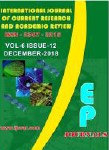Abstract Volume:6 Issue-12 Year-2018 Original Research Articles
 |
Online ISSN : 2347 - 3215 Issues : 12 per year Publisher : Excellent Publishers Email : editorijcret@gmail.com |
2Department of Plant Pest and Disease, Hasanuddin University, Makassar, South Sulawesi 90245, Indonesia
Grain Rot Disease (Bacterial Grain Rot) or Bacterial Panicle Blight becomes a serious threat to rice farmers in Indonesia. Agricultural Quarantine Office in Makassar (2016) and Pare-Pare (2017) confirmed that this disease has spread throughout the rice development area in South Sulawesi, but unfortunately Food Crops and Horticulture Protection Service has not made this disease as the main disease that should be monitored regularly. This is probably due to the difficulty of control measures as the symptoms of BG disease which in general occur only when the phase is generative and often the symptoms are confused with other pest symptoms such as blast, bacterial blight, stink bugor others. To overcome this problem, a fast, accurate, and simple method must be developed to diagnose the causal agent. To evaluate this method 8 isolates of Bulkholderia glumae were obtained from several varieties and several locations. For comparison, several pathogenic bacterial isolates in rice plants. The KOH3% test results showed that the whole isolates were negative. In the media King’s B shows positive in the production of toxoflavin, catalase and negative results in the arginine dehydrolase test, levan production, and gelatin liquefaction tests. The occurrence of maceration symptoms in onion slices provides more convincing evidence for the presence of B. glumae bacteria in rice. The hypersensitive reaction test in tobacco cannot be used as a benchmark because only 5 isolates react positively while the other 3 isolates react negatively. Through a series of results the tests showed differences in the characteristics of B. glumae bacteria with bacteria that cause rice diseases such as: Xanthomonas oryzae pv oryzae (leaf blight), X. oryzae pv oryzycola (leaf streak), so that the method can be used by pest observers and students to determine quickly, accurately, and simple for the presence of B. glumae bacteria in rice. The accuracy of the system will then be confirmed through molecular testing with specific primers.
How to cite this article:
Ikhwana Aflaha, Baharuddin and danUntung Surapati. 2018. The Development of Rapid, Accurate and Simple Identification Techniques for Bacterial Grain Rot (Burkholderia glumae) on Rice.Int.J.Curr.Res.Aca.Rev. 6(12): 1-6doi: https://doi.org/10.20546/ijcrar.2018.612.001



Quick Navigation
- Print Article
- Full Text PDF
- How to Cite this Article
- on Google
- on Google Scholor
- Citation Alert By Google Scholar
